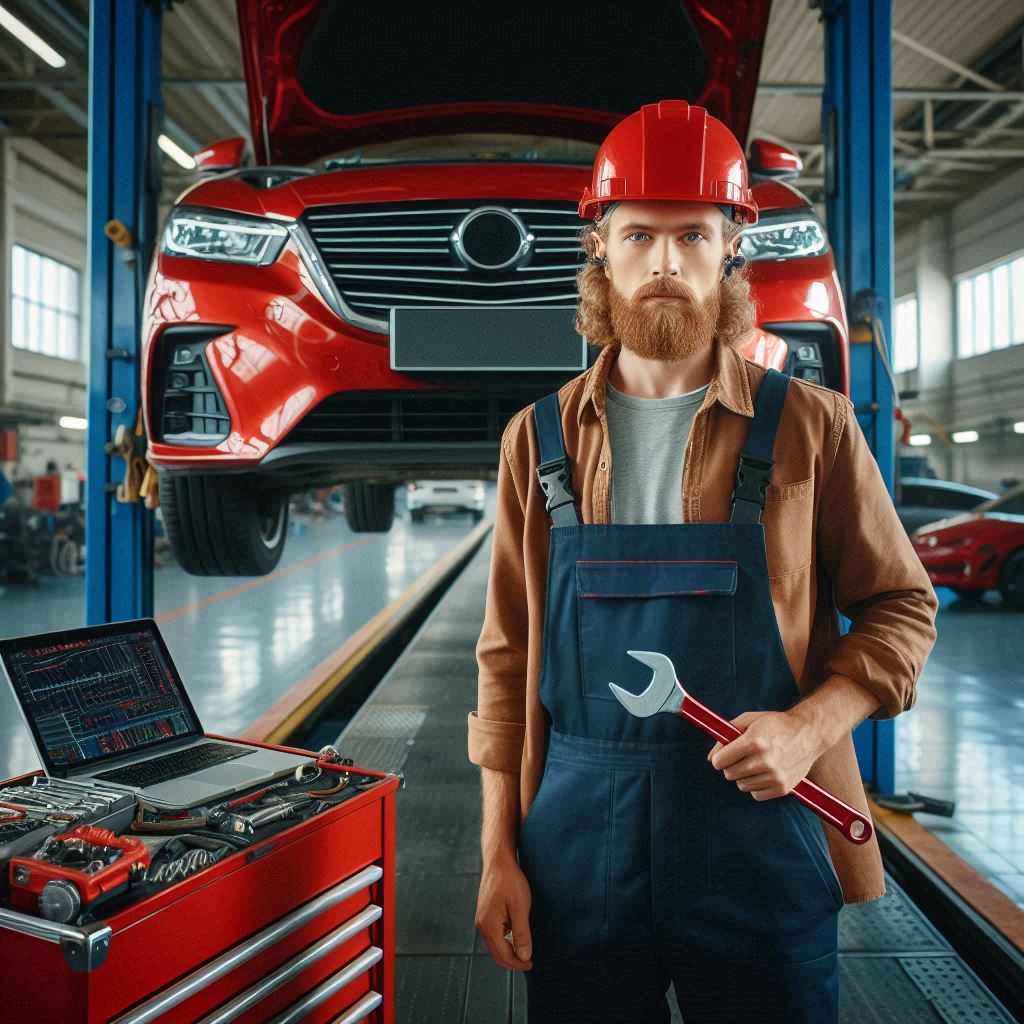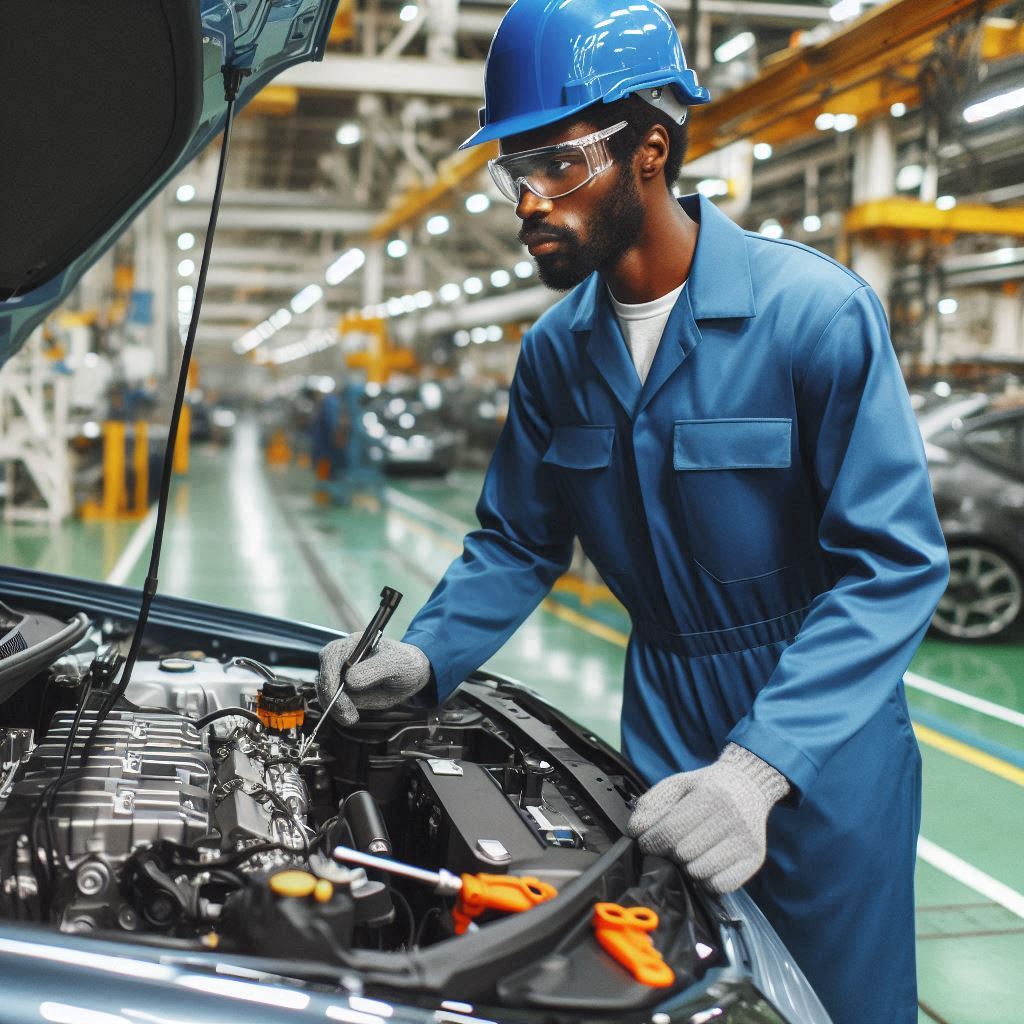Introduction
The Role of an Automotive Engineer
An automotive engineer designs, develops, and improves vehicles.
They focus on various aspects, including vehicle design, manufacturing processes, and system integration.
Their expertise ensures that vehicles are safe, efficient, and reliable.
Automotive engineers work on everything from the initial concept of a vehicle to its final production.
They collaborate with other engineers and specialists to create cutting-edge technologies and ensure that vehicles meet all safety and performance standards.
The Importance of Automotive Engineers in the Automotive Industry
Automotive engineers are vital to the automotive industry.
They drive innovation, ensuring vehicles meet evolving safety standards and environmental regulations.
Their work is crucial in developing new technologies, such as electric and autonomous vehicles, which are transforming the future of transportation.
By developing more efficient engines, advanced safety systems, and eco-friendly solutions, automotive engineers help reduce the environmental impact of vehicles.
Their contributions lead to safer, more reliable, and more sustainable transportation solutions.
As the industry continues to evolve, the role of automotive engineers will remain essential in addressing the challenges and opportunities of modern mobility.
Morning Routine
The Typical Morning Routine of an Automotive Engineer
The day of an automotive engineer starts early and purposeful.
They usually wake up around 6 a.m.
The first action is often a quick check of emails.
This helps them stay updated with any urgent issues.
Following this, they might review their to-do list.
A clear plan of action sets a productive tone for the day.
Breakfast is a crucial part of the routine.
It provides the necessary energy for the busy day ahead.
Some engineers prefer a light, nutritious meal to stay alert.
A morning workout or brief exercise session is also common.
Physical activity helps in maintaining focus and reducing stress.
By 7:30 a.m., many engineers head to their workplace.
They prefer arriving early to organize their workspace.
A clutter-free desk fosters better concentration.
Reviewing the day‘s schedule and meetings ensures they are prepared.
Prioritizing tasks helps in managing time effectively.
A typical morning may include a brief team meeting.
This session allows engineers to discuss ongoing projects and any challenges.
Clear communication is vital for collaboration and problem-solving.
Setting daily goals during the meeting helps keep everyone on track.
Checking project updates and deadlines is also part of the morning routine.
Automotive engineers need to stay on top of technical details and project milestones.
They may review design specifications or engineering reports to ensure accuracy.
Morning routines often involve addressing any pressing issues from the previous day.
This might include troubleshooting problems or coordinating with other departments.
Being proactive in the morning helps prevent bottlenecks and delays.
The Importance of Starting the Day with a Clear Plan of Action
The importance of a structured morning routine cannot be overstated.
It allows engineers to start their day with a clear mind and purpose.
A well-organized start can enhance productivity and efficiency throughout the day.
Engineers who begin their day with intention are better equipped to handle unexpected challenges.
A clear plan of action in the morning sets the stage for a focused and productive day.
It helps engineers manage their time effectively and avoid last-minute rushes.
Prioritizing tasks and reviewing schedules ensures that critical deadlines are met.
Overall, a disciplined morning routine contributes to success in the field of automotive engineering.
Read: Graduate Studies in Biomedical Engineering
Design and Development Tasks
Automotive engineers play a crucial role in the design and development of vehicles.
Their work involves a blend of technical expertise and creative thinking.
Here’s an overview of the typical tasks they handle:
The Design and Development Tasks Carried Out by Automotive Engineers
Design and development tasks start with understanding project requirements.
Engineers gather detailed specifications and constraints from clients or stakeholders.
They then translate these requirements into technical blueprints and models.
Using advanced software, automotive engineers create 3D models of new vehicle components.
This stage involves extensive computer-aided design (CAD) to visualize and refine concepts.
Engineers must consider factors like aerodynamics, safety, and cost during this process.
Next, they conduct simulations and analyses to test their designs.
These tests help identify potential issues and areas for improvement.
Engineers use tools like finite element analysis (FEA) to predict how components will behave under stress.
Prototyping is another key task.
Engineers build physical prototypes to evaluate design performance in real-world conditions.
This hands-on phase allows them to make necessary adjustments and ensure quality.
Collaboration with other departments is vital.
Automotive engineers work closely with manufacturing teams to ensure designs are feasible for production.
They also coordinate with suppliers to source materials and components.
Finally, they oversee the testing and validation of final products.
Engineers conduct rigorous tests to ensure vehicles meet safety and performance standards.
They document their findings and make final adjustments before production.
The Creative Aspects of Designing New Automotive Systems and Components
Designing new automotive systems and components requires a high degree of creativity.
Engineers must think outside the box to innovate and improve vehicle performance.
They often brainstorm and sketch initial ideas before developing detailed models.
Creativity comes into play when balancing form and function.
Engineers strive to create aesthetically pleasing designs that also meet technical requirements.
This involves experimenting with different shapes, materials, and technologies.
Sustainability is a growing focus in automotive design.
Engineers use their creativity to develop eco-friendly solutions.
This might include designing components for electric vehicles or optimizing fuel efficiency.
Innovation is at the heart of automotive engineering.
Engineers continually explore new materials and technologies to enhance vehicle capabilities.
This includes integrating advanced electronics and smart systems into vehicle designs.
User experience is another area where creativity shines.
Engineers design features that improve driver comfort and safety.
This might involve developing intuitive control interfaces or enhancing interior ergonomics.
In essence, the design and development tasks of automotive engineers are multifaceted and demanding.
They require a blend of technical skills and creative thinking.
Engineers must innovate continually to meet the evolving demands of the automotive industry.
Their work results in safer, more efficient, and more enjoyable vehicles for consumers.
Read: Networking Tips for Biomedical Engineers
Collaborations with Team Members
Collaboration is at the heart of automotive engineering.
Engineers work together to tackle complex problems and deliver innovative solutions.
Effective teamwork ensures that projects run smoothly and efficiently.
The Importance of Collaboration with Other Team Members
Collaboration among team members is essential in automotive engineering.
No single engineer can master every aspect of vehicle design and development.
Each team member brings unique skills and expertise to the table.
This diversity fosters comprehensive problem-solving and innovation.
Clear communication is a key component of successful collaboration.
Engineers must convey their ideas and findings effectively to their colleagues.
This ensures everyone is on the same page and can contribute to the project‘s goals.
Regular meetings and updates help maintain transparency and alignment within the team.
Collaboration also enhances learning and professional growth.
Engineers learn from each other‘s experiences and perspectives.
This continuous exchange of knowledge helps them stay updated with the latest technologies and best practices.
It also fosters a culture of mutual respect and support.
Working collaboratively reduces the risk of errors and oversights.
When multiple experts review and refine a design, they can catch potential issues early.
This proactive approach saves time and resources in the long run.
It also improves the overall quality and safety of the final product.
Examples of How Teamwork Plays a Crucial Role in the Success of Automotive Engineering Projects
One example of successful teamwork in automotive engineering is the development of new vehicle models.
Designing a new car involves various stages, from concept to production.
Engineers specializing in different areas, such as aerodynamics, electronics, and materials, must work together.
Their combined efforts ensure the vehicle meets performance, safety, and aesthetic standards.
During the prototype testing phase, teamwork is vital.
Engineers from design, production, and quality assurance departments collaborate to evaluate the prototype.
They test its performance, identify issues, and implement solutions.
This iterative process relies on constant communication and cooperation among team members.
Another example is the integration of new technologies, like autonomous driving systems.
Developing these systems requires expertise in software, hardware, and safety protocols.
Engineers from different disciplines must collaborate to create a cohesive and functional system.
They must also work closely with regulatory bodies to ensure compliance with safety standards.
In project management, cross-functional teams are often formed to tackle specific challenges.
For instance, if a new material is introduced, material scientists, design engineers, and manufacturing experts must collaborate.
They assess the material‘s properties, how it affects the design, and the best methods for manufacturing.
Successful automotive engineering projects often involve partnerships with external organizations.
Engineers may collaborate with universities, research institutions, and suppliers.
These collaborations bring in additional expertise and resources, driving innovation and efficiency.
Generally, collaboration is crucial in automotive engineering.
It leverages the diverse skills of team members to achieve common goals.
Effective teamwork enhances problem-solving, innovation, and quality.
By working together, engineers can deliver safer, more advanced, and reliable vehicles.
Read: Biomedical Engineer: Working in Healthcare Tech

Testing and Analysis Procedures
Testing and analysis are critical components of automotive engineering.
These procedures ensure that vehicles meet safety, performance, and regulatory standards. Here’s an overview of the typical processes automotive engineers follow:
The Testing and Analysis Procedures Conducted by Automotive Engineers
Preliminary Testing
- Component Testing: Engineers test individual components, such as engines, brakes, and electronic systems, to ensure they meet performance specifications.
- Material Testing: They evaluate materials for durability, strength, and resistance to environmental factors.
Simulation and Modeling
- Computer-Aided Engineering (CAE): Engineers use CAE tools to simulate vehicle performance under various conditions. This includes crash simulations, thermal analysis, and aerodynamic testing.
- Finite Element Analysis (FEA): FEA helps predict how components will react to stress, heat, and vibration. This analysis ensures parts are designed for optimal durability and safety.
Prototyping
- Building Prototypes: Engineers create physical prototypes to test the design’s real-world performance. Prototypes are often subjected to rigorous testing to identify potential issues.
- Iterative Testing: Multiple prototypes may be built and tested iteratively. Each version incorporates improvements based on previous test results.
Performance Testing
- Dynamic Testing: Engineers evaluate the vehicle’s handling, stability, and ride quality through dynamic tests. This includes tests on various road conditions and at different speeds.
- Engine and Drivetrain Testing: They assess engine performance, fuel efficiency, and emissions. Drivetrain components, such as transmission and differential, are also tested for reliability and performance.
Safety Testing
- Crash Testing: Vehicles undergo crash tests to evaluate their structural integrity and occupant protection. These tests are conducted in controlled environments to simulate real-world collisions.
- Safety Feature Testing: Engineers test safety systems like airbags, seatbelts, and electronic stability control to ensure they function correctly under different scenarios.
Environmental Testing
- Weather Testing: Vehicles are tested in various weather conditions, including extreme heat, cold, and humidity, to ensure they perform reliably in all climates.
- Corrosion Testing: Engineers assess the vehicle’s resistance to rust and corrosion, particularly in components exposed to harsh environments.
How Data Analysis Plays a Key Role in Improving Automotive Designs
Data analysis is integral to the testing and analysis procedures in automotive engineering.
It helps engineers understand performance metrics, identify weaknesses, and implement improvements. Here‘s how it plays a crucial role:
Performance Metrics
- Data Collection: During testing, engineers collect vast amounts of data on various performance aspects, such as acceleration, braking, and fuel efficiency.
- Analysis Tools: They use specialized software to analyze this data, identifying trends and outliers that indicate potential issues.
Identifying Weaknesses
- Root Cause Analysis: Engineers conduct root cause analysis to determine the underlying causes of failures or suboptimal performance. This involves examining test data to pinpoint specific areas needing improvement.
- Comparative Analysis: By comparing data from different prototypes or test conditions, engineers can identify design elements that perform better or worse than expected.
Implementing Improvements
- Iterative Design: Data analysis informs the iterative design process. Engineers use insights from data to refine their designs, making adjustments to materials, structures, or systems.
- Optimization: Engineers optimize vehicle components based on data-driven insights. This includes enhancing material properties, improving aerodynamics, and fine-tuning engine performance.
Ensuring Compliance
- Regulatory Standards: Data analysis ensures that vehicles meet regulatory standards for safety, emissions, and performance. Engineers use data to validate that their designs comply with industry regulations.
- Documentation: Comprehensive data analysis provides the necessary documentation to demonstrate compliance during regulatory reviews.
Predictive Maintenance
- Failure Prediction: Engineers use data analysis to predict potential failures before they occur. This involves analyzing trends and patterns in component wear and tear.
- Maintenance Scheduling: Predictive maintenance schedules are developed based on data insights, ensuring vehicles remain in optimal condition and reducing downtime.
Testing and analysis procedures are essential for ensuring the safety, reliability, and performance of automotive designs.
Data analysis plays a pivotal role in these processes, providing engineers with the insights needed to continually improve and innovate.
Through rigorous testing and data-driven decision-making, automotive engineers create vehicles that meet the highest standards of quality and performance.
One common challenge faced by automotive engineers is designing efficient fuel systems for cars.
To overcome this challenge, problem-solving skills such as analyzing data and optimizing fuel delivery systems are crucial.
Another challenge is ensuring vehicle safety standards are met while also meeting performance requirements.
Problem-solving skills required for this include conducting crash tests and simulations to identify potential safety issues.
Transform Your Career Today
Unlock a personalized career strategy that drives real results. Get tailored advice and a roadmap designed just for you.
Start NowEngineers also face challenges related to implementing new technologies in vehicles, such as autonomous driving systems.
To address this, problem-solving skills like researching and testing new technologies are essential to ensure successful integration.
Additionally, automotive engineers often encounter obstacles in reducing vehicle emissions to meet environmental regulations.
Problem-solving skills like developing alternative fuel sources or optimizing engine performance can help overcome these challenges.
Read: The Impact of Aerospace Engineering on Modern Life
Problem-Solving Scenarios
Automotive engineers encounter various challenges that test their problem-solving skills and technical expertise.
Overcoming these obstacles requires a combination of analytical thinking, creativity, and collaboration.
Examples of Common Challenges Faced by Automotive Engineers
Design Flaws
- Example: During the development of a new vehicle model, engineers may discover that a particular component design causes unexpected vibrations.
- Challenge: Identifying the root cause of the vibration and redesigning the component without compromising other aspects of the vehicle’s performance.
Material Selection
- Example: Engineers might need to find a material that is both lightweight and strong enough to meet safety standards.
- Challenge: Balancing weight reduction with structural integrity and cost considerations, especially for high-performance or electric vehicles.
Emission Standards Compliance
- Example: New regulations may require a significant reduction in vehicle emissions.
- Challenge: Developing and integrating new technologies, such as advanced exhaust systems or hybrid powertrains, to meet these standards without sacrificing performance.
Noise, Vibration, and Harshness (NVH) Issues
- Example: Customers may report excessive cabin noise at high speeds in a newly released vehicle model.
- Challenge: Analyzing the source of the noise and implementing solutions, such as better insulation or design modifications, to enhance passenger comfort.
Integration of Advanced Technologies
- Example: Incorporating autonomous driving features into existing vehicle platforms.
- Challenge: Ensuring that sensors, cameras, and software systems work seamlessly together while maintaining overall vehicle safety and reliability.
The Problem-Solving Skills Required to Overcome Obstacles in the Field
Analytical Thinking
- Skill: The ability to systematically analyze complex problems and break them down into manageable parts.
- Application: Engineers use this skill to diagnose issues, such as identifying the source of a design flaw or determining the best material for a specific application.
Creativity
- Skill: Thinking outside the box to develop innovative solutions to engineering challenges.
- Application: When faced with a design limitation, engineers might explore unconventional materials or novel design approaches to meet performance goals.
Technical Expertise
- Skill: Deep understanding of engineering principles, materials science, and vehicle dynamics.
- Application: Technical knowledge is crucial when evaluating the feasibility of proposed solutions and ensuring they comply with industry standards and regulations.
Collaboration
- Skill: Working effectively with cross-functional teams, including design, manufacturing, and quality assurance.
- Application: Collaborative efforts are essential when integrating new technologies, addressing NVH issues, or ensuring that a redesign meets all project requirements.
Adaptability
- Skill: Being flexible and willing to adjust plans based on new information or changing conditions.
- Application: Engineers must quickly adapt to new regulatory requirements or customer feedback, making necessary adjustments to designs or production processes.
Project Management
- Skill: Planning and managing projects to ensure timely and cost-effective delivery.
- Application: Effective project management involves setting clear goals, allocating resources efficiently, and keeping the team focused on meeting deadlines.
Attention to Detail
- Skill: Ensuring that every aspect of a design or solution meets the highest standards of quality and precision.
- Application: This skill is vital in tasks such as fine-tuning component designs, conducting thorough testing, and documenting findings accurately.
Communication
- Skill: Clearly conveying ideas, findings, and solutions to team members, stakeholders, and customers.
- Application: Engineers must explain complex technical concepts in understandable terms and ensure that all parties are aligned on project goals and progress.
Automotive engineers face a variety of challenges that require a diverse set of problem-solving skills.
By applying analytical thinking, creativity, technical expertise, and effective collaboration, they can overcome obstacles and drive innovation in vehicle design and development.
These skills are essential for ensuring that vehicles meet performance, safety, and regulatory standards, ultimately leading to successful project outcomes and satisfied customers.
Industry Trends and Innovations
The automotive industry is rapidly evolving, driven by technological advancements and changing consumer preferences.
Automotive engineers play a pivotal role in embracing these trends and driving innovations.
The Current Trends and Innovations in the Automotive Industry
Electric Vehicles (EVs)
- Trend: The shift towards electric vehicles is accelerating, with major manufacturers committing to electric models.
- Innovation: Engineers are developing advanced battery technologies, such as solid-state batteries, to enhance range and reduce charging times.
Autonomous Driving
- Trend: Autonomous driving technology is progressing, aiming for higher levels of vehicle autonomy.
- Innovation: Engineers are working on sophisticated sensor systems, machine learning algorithms, and AI to enable safe and reliable self-driving cars.
Connectivity
- Trend: Vehicles are becoming increasingly connected, offering enhanced features and integration with smart devices.
- Innovation: Engineers develop in-car infotainment systems, vehicle-to-everything (V2X) communication, and over-the-air (OTA) updates to improve user experience and vehicle functionality.
Sustainability
- Trend: There is a growing focus on sustainability and reducing the automotive industry’s environmental impact.
- Innovation: Engineers are exploring renewable materials, eco-friendly manufacturing processes, and recycling initiatives to create greener vehicles.
Advanced Safety Features
- Trend: Enhanced safety features are becoming standard in modern vehicles.
- Innovation: Engineers design advanced driver-assistance systems (ADAS) such as automatic emergency braking, lane-keeping assist, and adaptive cruise control to improve safety on the road.
Lightweight Materials
- Trend: Reducing vehicle weight is crucial for improving fuel efficiency and performance.
- Innovation: Engineers are utilizing lightweight materials like carbon fiber, aluminum, and high-strength steel to design stronger yet lighter vehicles.
Alternative Fuels
- Trend: There is increasing interest in alternative fuels like hydrogen and biofuels.
- Innovation: Engineers are developing hydrogen fuel cells and exploring biofuel applications to diversify the energy sources for vehicles.
Personalization
- Trend: Consumers demand more personalized vehicle features and options.
- Innovation: Engineers create customizable interfaces, adjustable driving modes, and modular vehicle designs to cater to individual preferences.
How Automotive Engineers Stay Updated with the Latest Technologies and Advancements
Automotive engineers stay updated with the latest technologies and advancements through several key methods.
They engage in continuous education by pursuing advanced degrees and certifications in emerging fields like electric vehicles and autonomous driving.
Professional associations, such as SAE, offer access to industry news and networking opportunities.
Engineers attend industry conferences and trade shows to see new technologies firsthand.
They read technical journals and publications to keep up with research findings.
Online learning platforms
The automotive industry is witnessing significant trends and innovations that are reshaping vehicle design and functionality.
Automotive engineers stay updated with the latest technologies through continuous education, professional associations, industry events, and collaborative projects.
By embracing these trends and continually enhancing their knowledge, engineers drive the evolution of the automotive industry, creating safer, more efficient, and more advanced vehicles.
During lunch breaks, automotive engineers typically take the opportunity to recharge and refuel both their bodies and minds.
Lunch Break and Networking
Automotive engineers use their lunch breaks to recharge, connect with colleagues, and advance their careers.
The midday break is more than just a chance to eat; it‘s a pivotal moment for both relaxation and professional growth.
How Automotive Engineers Make Use of Their Lunch Breaks
Many engineers start their lunch break by catching up with their colleagues.
They discuss ongoing projects or share updates on industry news.
This social interaction fosters teamwork and strengthens relationships within the department.
It‘s also a time to share insights or brainstorm informal solutions to engineering problems.
For some engineers, lunch is an opportunity for informal meetings.
They might use this time to discuss project details or new ideas with peers.
These discussions often lead to innovative solutions and improve project outcomes.
Engineers also take this time to stay informed by reading industry news or technical articles.
Relaxation is another key aspect of the lunch break.
Engineers often step away from their desks to enjoy a meal and unwind.
This break helps reduce stress and recharges their energy levels for the afternoon.
A relaxed mind enhances focus and productivity in the second half of the day.
Lunch breaks can also be used for professional development.
Engineers might watch educational videos or complete short online courses.
This ongoing learning helps them stay current with new technologies and practices.
Personal growth during lunch breaks contributes to overall career advancement.
The Importance of Networking Within the Industry for Career Growth
Networking is crucial for career growth in the automotive industry.
Building professional relationships provides valuable connections with industry peers and leaders.
These relationships can lead to new job opportunities and career advancements.
Many positions are filled through referrals rather than traditional job postings.
Industry insights gained through networking are invaluable.
Engineers who connect with others in the field stay informed about the latest
Delve into the Subject: Quality Control Inspection Standards Explained
Delve into the Subject: Radiologic Technologist: Job Demand by State
Wrap-Up Tasks and Reflection
The Tasks Completed by an Automotive Engineer at the End of the Day
At the end of the day, an automotive engineer wraps up by reviewing their accomplishments and pending tasks.
They first check their to-do list and update the status of each item.
If necessary, they document the progress and any issues encountered during the day.
This helps in maintaining a clear record of what was achieved and what still needs attention.
Engineers often spend time preparing detailed reports about their day’s work.
These reports include data analysis, design changes, and any testing outcomes.
They ensure that all documentation is accurate and complete, as this information will be crucial for future projects.
Reviewing daily work also involves discussing completed tasks with team members.
Engineers may hold brief meetings or check-ins to share insights and address any concerns.
Collaboration is key to ensuring that every aspect of a project is aligned with the overall goals.
The Importance of Reflection and Continuous Improvement in the Field
Reflection is a critical part of this wrap-up process.
Engineers take time to evaluate their performance and identify areas for improvement.
They consider what went well and what challenges they faced.
This reflection helps them understand their strengths and recognize opportunities for growth.
Continuous improvement is a fundamental aspect of an automotive engineer‘s role.
By regularly reflecting on their work, engineers can implement changes that enhance their efficiency and effectiveness.
This might involve adopting new technologies, refining processes, or seeking additional training.
The end-of-day routine also includes organizing the workspace for the next day.
Engineers ensure that all tools and materials are in their proper places.
This preparation helps to start the next day with a clear focus and without unnecessary delays.
Overall, the wrap-up tasks and reflection phase is crucial for maintaining high standards in automotive engineering.
It ensures that engineers remain organized, aware of their progress, and committed to continuous improvement.
By making reflection a daily habit, engineers can consistently deliver quality results and stay at the forefront of their field.
Conclusion
The Key Points Discussed in the Blog Post
Becoming an automotive engineer is a rewarding journey.
Start with a bachelor‘s degree in engineering or a related field.
Gain practical experience through internships, which provide valuable insights and skills.
Specializing in areas like vehicle design, manufacturing, or electronics will enhance your career prospects.
Networking with industry professionals and engaging in continuous learning are vital to staying ahead in this ever-evolving field.
The Vital Role of Automotive Engineers in Shaping the Future of the Automotive Industry
Automotive engineers play a crucial role in the future of transportation.
They are at the forefront of developing technologies that make vehicles safer, more efficient, and environmentally friendly.
From designing electric and autonomous vehicles to improving fuel efficiency and safety features, their work drives significant advancements in the industry.
Automotive engineers are essential for addressing the challenges of modern transportation and shaping the future of mobility.
By following the career path outlined in this blog post, you can become an integral part of this exciting and impactful field.
Transform Your Career Today
Unlock a personalized career strategy that drives real results. Get tailored advice and a roadmap designed just for you.
Start Now



